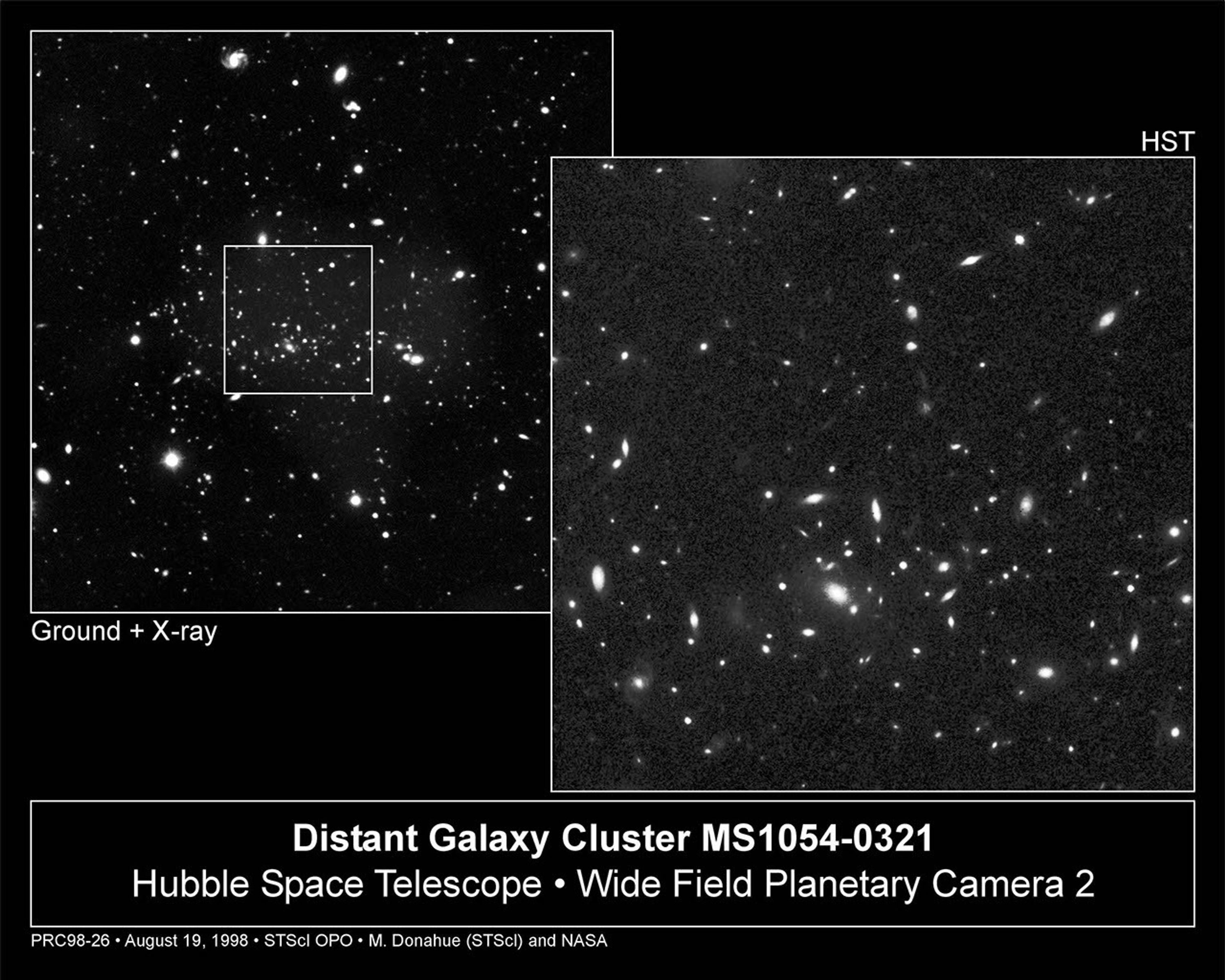A Space Telescope Science Institute astronomer has found the equivalent of the proverbial 900-pound gorilla in deep space. The "gorilla" is an extremely massive cluster of galaxies - the weight of several thousand of our Milky Ways - that existed when the universe was half its present age.
Paradoxically, the unexpected discovery of this ancient, heavyweight cluster is one of the strongest pieces of evidence yet that we live in a lightweight universe, one that doesn't have enough bulk to provide the gravity necessary to halt the expansion of space.
Using X-ray satellites and ground-based telescopes to probe the remote regions of space, Institute astronomer Megan Donahue discovered MS1054-0321, a hefty galaxy cluster containing thousands of galaxies and many trillions of stars. The cluster is 8 billion light-years from Earth.
Besides being one of the heaviest clusters, it is also one of the hottest on record. The temperature of its intergalactic gas measures 300 million degrees Fahrenheit. Donahue's observations of this heavyweight cluster, along with her analysis of four other less distant but nearly as massive clusters, suggests that the early universe was a busy construction zone that has now slowed its activity, as expected of a low-density universe.
Unearthing such a well-defined cluster at a time when the universe was so young was a surprise to Donahue, who reported her results in the Aug. 1 issue of the Astrophysical Journal.
"When I first began studying this massive cluster, I expected to see lots of cool lumps, based on conventional theories of cluster evolution, which hold that clusters grow over long periods of time," Donahue said. "Instead, I found a huge, hot, well-structured cluster of galaxies."
"If clusters have indeed been growing all along, we're looking back to a time where there shouldn't have been any massive clusters at all, and we're finding some. Our conclusion is that clusters of galaxies have slowed their growth rate significantly over the last 5 billion years or so, and that slower growth rate implies that the universe isn't dense enough to stop expanding," Donahue said.
Added co-investigator Mark Voit, also an Institute astronomer: "I estimate that the odds of finding such a massive cluster so far in the past, given the standard picture of a dense universe, are about 1 in 100,000."
In this traditional view of the universe, space holds just enough matter to be on the cusp of expanding forever or collapsing under its own weight into a reverse Big Bang. If this theory is true, then finding such a massive cluster so early in time is extremely unlikely, Donahue said. In a dense universe, clusters of galaxies grow continuously, getting more massive with every epoch. Therefore, astronomers expect to find fewer massive clusters in the past - if clusters have been growing continuously all along. The growth rate of clusters depends on how much matter is in space. A small change in the density of the universe creates a huge variation in the growth rate of clusters.
Donahue selected MS1054-0321 because it is the most distant cluster in the Einstein Extended Medium Sensitivity Survey, a catalogue of the brightest galaxy clusters at far-flung distances. Several members of Donahue's team compiled the survey from observations made by the Einstein Observatory, an orbiting satellite, from 1978 to 1981. The cluster's distance and an independent estimate of its mass were confirmed by team member Isabella Gioia using the ground-based Canada-France-Hawaii telescope in Hawaii.
Donahue also calculated the total amount of matter in the cluster by analyzing its X-ray emissions. Those observations were made in 1995 and 1996 by two orbiting observatories, the Advanced Satellite for Cosmology and Astrophysics (ASCA), jointly operated by Japan and the U.S., and the Roentgen Satellite, known as Rosat, operated by the U.S., Germany, and the United Kingdom.
The emissions show that the space between the galaxies in the cluster is filled with a huge amount of extremely hot gas. This gas should have dissipated into space long ago, like steam escaping from a hot kettle. Instead, the gravitational pull of an immense amount of mass has contained this hot gas within the cluster. Because the amount of visible mass isn't enough to confine the gas within the cluster, Donahue reasoned, there must be plenty of invisible, "dark matter" around. Dark matter, many astronomers believe, constitutes most of the material in space.
Knowing how much matter is necessary to keep the cluster together enabled Donahue to calculate its total mass. Based on her calculations, the cluster has an estimated mass of 1 quadrillion suns. Most of it, however, is in the form of dark matter, which is up to 10 times the mass of the normal material.
Donahue's results support a growing consensus among astronomers that the universe will expand forever. Earlier this year, several teams of astronomers announced similar results using different methods, including measuring the expansion rate of the universe and the sizes and distances to remote galaxies.
The astronomer's next step is to sample the cluster's visible light with the Hubble Space Telescope's Wide Field and Planetary Camera 2. With Hubble's sharp eyes, Donahue hopes to classify the types of galaxies in the cluster, pinpoint the concentration of star birth, and study how the cluster neighborhood may have affected the lives and past histories of the galaxies dwelling within.
By pure coincidence, in 1996 the Hubble telescope captured the light of an exploding star, supernova 1996CL, in this distant cluster of galaxies. At the time the Hubble pictures were taken, 1996CL was the most distant supernova known. Members of the Supernova Cosmology Project, led by Saul Perlmutter of Lawrence Berkeley Laboratory in California, used the 1996CL data to demonstrate that the Hubble telescope is capable of imaging distant supernovae and their host galaxies even halfway across the universe. Such distant supernovae are so far away that they are used to measure the acceleration or deceleration of the expansion rate of the universe, the goal of Perlmutter's Supernova Project.
Donahue's main collaborators are Isabella Gioia of the University of Hawaii, John Stocke of the University of Colorado, John Hughes of Rutgers University, and Mark Voit of the Space Telescope Science Institute.


































